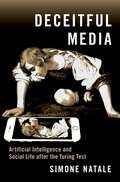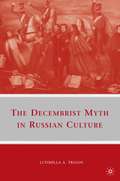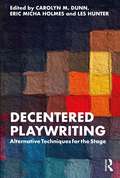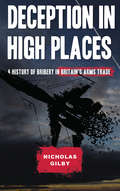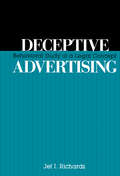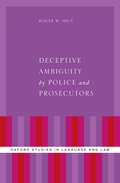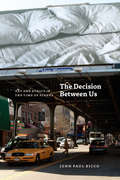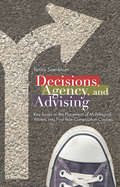- Table View
- List View
Decades (Modern Plays)
by Leo ButlerThe world's changin', we don't have to just 'make do' anymore. There's stuff out there, there's life, there's … people and experiencin' somethin' meaningful. California, 'Arry, Woodstock, out on the road like a rollin' bloody stone, it's Dylan, 'Arry, that's who I want to be. Yer seriously think I'm goin' to stick round here.Modern life isn't easy and it never has been. This explosive play by Leo Butler transports us through time, looking at what happens when the next generation begin to find their feet in an ever-changing world. Through a kaleidoscope of characters, we see tensions rocket and values crumble, exposing the best and worst of what it means to be human. This epic roller coaster of a play combines euphoria and despair as different generations of young people ask the same question: where do we go from here?Decades received its world premiere at Ovalhouse, London, on 7 June 2016 in a production by Brit School for Performing Arts and Technology.
Decades (Modern Plays)
by Leo ButlerThe world's changin', we don't have to just 'make do' anymore. There's stuff out there, there's life, there's … people and experiencin' somethin' meaningful. California, 'Arry, Woodstock, out on the road like a rollin' bloody stone, it's Dylan, 'Arry, that's who I want to be. Yer seriously think I'm goin' to stick round here.Modern life isn't easy and it never has been. This explosive play by Leo Butler transports us through time, looking at what happens when the next generation begin to find their feet in an ever-changing world. Through a kaleidoscope of characters, we see tensions rocket and values crumble, exposing the best and worst of what it means to be human. This epic roller coaster of a play combines euphoria and despair as different generations of young people ask the same question: where do we go from here?Decades received its world premiere at Ovalhouse, London, on 7 June 2016 in a production by Brit School for Performing Arts and Technology.
The Decameron: Prencipe Galeotto (World's Classics)
by Giovanni Boccaccio G. H. McWilliamIn the summer of 1348, as the Black Death ravages their city, ten young Florentines take refuge in the countryside. They amuse themselves by each telling a story a day for the ten days they are destined to remain there - a hundred stories of love, adventure and surprising twists of fate. Less preoccupied with abstract concepts of morality or religion than earthly values, the tales range from the bawdy Peronella hiding her lover in a tub to Ser Cepperallo, who, despite his unholy effrontery, becomes a Saint. The result is a towering monument of European literature and a masterpiece of imaginative narrative.
Decapitation in Sources on Alexander the Great
by Marc MendozaThis book explores cases of decapitation found in sources on the reign of Alexander the Great. Despite the enormous literature on the career of Alexander the Great, this is the first study on the characterisation of violent deaths during his hectic reign. This historiographical omission has involved the tacit and blind acceptance of the details found in the ancient sources. Therefore, this book seeks to illustrate how cultural expectations, literary models, and ideological taboos shaped these accounts and argues for a close and critical reading of the sources. Given the different cultural considerations surrounding decapitation in Greek and Roman cultures, this book illustrates how those biases could have differently shaped certain episodes depending on the ultimate writer.This book, therefore, can be especially interesting for scholars focused on the career of Alexander the Great, but also valuable for other Classicists, philologists, and even for anthropologists because it represents a good case of study of cultural symbolism of violent death, semantics of power, imperial domination and the confrontation between opposite cultural appreciations of a practice.
Decay and Afterlife: Form, Time, and the Textuality of Ruins, 1100 to 1900
by Aleksandra PricaCovering 800 years of intellectual and literary history, Prica considers the textual forms of ruins. Western ruins have long been understood as objects riddled with temporal contradictions, whether they appear in baroque poetry and drama, Romanticism’s nostalgic view of history, eighteenth-century paintings of classical subjects, or even recent photographic histories of the ruins of postindustrial Detroit. Decay and Afterlife pivots away from our immediate, visual fascination with ruins, focusing instead on the textuality of ruins in works about disintegration and survival. Combining an impressive array of literary, philosophical, and historiographical works both canonical and neglected, and encompassing Latin, Italian, French, German, and English sources, Aleksandra Prica addresses ruins as textual forms, examining them in their extraordinary geographical and temporal breadth, highlighting their variability and reflexivity, and uncovering new lines of aesthetic and intellectual affinity. Through close readings, she traverses eight hundred years of intellectual and literary history, from Seneca and Petrarch to Hegel, Goethe, and Georg Simmel. She tracks European discourses on ruins as they metamorphose over time, identifying surprising resemblances and resonances, ignored contrasts and tensions, as well as the shared apprehensions and ideas that come to light in the excavation of these discourses.
The Decay of Lying: And Other Essays
by Oscar WildeIn 'The Decay of Lying' Oscar Wilde uses his decadent ideology in an attempt to reverse and therefore reject his audiences' 'normal' conceptualizations of nature, art and morality. Wilde's views of life and art are illustrated through the use of Platonic dialogue where the character Vivian takes on the persona of Wilde. Wilde's goal is to subvert the norm by reversing its values. Wilde suggests to us that society is wrong, not him. Calling on diverse examples - from Ancient Greek sculpture to contemporary paintings - Oscar Wilde's brilliant essay creates a witty, paradoxical world in which the only Art worth loving is that built on complete untruths.
Deceitful Media: Artificial Intelligence and Social Life after the Turing Test
by Simone NataleArtificial intelligence (AI) is often discussed as something extraordinary, a dream--or a nightmare--that awakens metaphysical questions on human life. Yet far from a distant technology of the future, the true power of AI lies in its subtle revolution of ordinary life. From voice assistants like Siri to natural language processors, AI technologies use cultural biases and modern psychology to fit specific characteristics of how users perceive and navigate the external world, thereby projecting the illusion of intelligence. Integrating media studies, science and technology studies, and social psychology, Deceitful Media examines the rise of artificial intelligence throughout history and exposes the very human fallacies behind this technology. Focusing specifically on communicative AIs, Natale argues that what we call "AI" is not a form of intelligence but rather a reflection of the human user. Using the term "banal deception," he reveals that deception forms the basis of all human-computer interactions rooted in AI technologies, as technologies like voice assistants utilize the dynamics of projection and stereotyping as a means for aligning with our existing habits and social conventions. By exploiting the human instinct to connect, AI reveals our collective vulnerabilities to deception, showing that what machines are primarily changing is not other technology but ourselves as humans. Deceitful Media illustrates how AI has continued a tradition of technologies that mobilize our liability to deception and shows that only by better understanding our vulnerabilities to deception can we become more sophisticated consumers of interactive media.
Deceitful Media: Artificial Intelligence and Social Life after the Turing Test
by Simone NataleArtificial intelligence (AI) is often discussed as something extraordinary, a dream--or a nightmare--that awakens metaphysical questions on human life. Yet far from a distant technology of the future, the true power of AI lies in its subtle revolution of ordinary life. From voice assistants like Siri to natural language processors, AI technologies use cultural biases and modern psychology to fit specific characteristics of how users perceive and navigate the external world, thereby projecting the illusion of intelligence. Integrating media studies, science and technology studies, and social psychology, Deceitful Media examines the rise of artificial intelligence throughout history and exposes the very human fallacies behind this technology. Focusing specifically on communicative AIs, Natale argues that what we call "AI" is not a form of intelligence but rather a reflection of the human user. Using the term "banal deception," he reveals that deception forms the basis of all human-computer interactions rooted in AI technologies, as technologies like voice assistants utilize the dynamics of projection and stereotyping as a means for aligning with our existing habits and social conventions. By exploiting the human instinct to connect, AI reveals our collective vulnerabilities to deception, showing that what machines are primarily changing is not other technology but ourselves as humans. Deceitful Media illustrates how AI has continued a tradition of technologies that mobilize our liability to deception and shows that only by better understanding our vulnerabilities to deception can we become more sophisticated consumers of interactive media.
Deceived With Kindness: A Bloomsbury Childhood
by Angelica GarnettAngelica Garnett may truly be called a child of Bloomsbury. Her Aunt was Virginia Woolf, her mother Vanessa Bell, and her father Duncan Grant, though for many years Angelica believed herself, naturally enough, the daughter of Vanessa's husband Clive. Her childhood homes, Charleston in Sussex and Gordon Square in London, were both centres of Bloomsbury activity, and she grew up surrounded by the most talked-about writers and artists of the day - Leonard and Virginia Woolf, Roger Fry, the Stracheys, Maynard Keynes, David Garnett (whom she later married), and many others. But Deceived with Kindness is also a record of a young girl's particular struggle to achieve independence from that extraordinary and intense milieu as a mature and independent woman. With an honesty that is by degrees agonising and uplifting, the author creates a vibrant, poignant picture of her mother, Vanessa Bell, of her own emergent individuality, and of the Bloomsbury era.
The Decembrist Myth in Russian Culture
by L. TrigosThis book is the first interdisciplinary treatment of the cultural significance of the Decembrists' mythic image in Russian literature, history, film and opera in a survey of its deployment as cultural trope since the original 1825 rebellion and through the present day.
Decentered Playwriting: Alternative Techniques for the Stage
by Carolyn M. DunnDecentered Playwriting investigates new and alternative strategies for dramatic writing that incorporate non-Western, Indigenous, and underrepresented storytelling techniques and traditions while deepening a creative practice that decenters hegemonic methods. A collection of short essays and exercises by leading teaching artists, playwrights, and academics in the fields of playwriting and dramaturgy, this book focuses on reimagining pedagogical techniques by introducing playwrights to new storytelling methods, traditions, and ways of studying, and teaching diverse narratological practices. This is a vital and invaluable book for anyone teaching or studying playwriting, dramatic structure, storytelling at advanced undergraduate and graduate levels, or as part of their own professional practice.
Decentered Playwriting: Alternative Techniques for the Stage
Decentered Playwriting investigates new and alternative strategies for dramatic writing that incorporate non-Western, Indigenous, and underrepresented storytelling techniques and traditions while deepening a creative practice that decenters hegemonic methods. A collection of short essays and exercises by leading teaching artists, playwrights, and academics in the fields of playwriting and dramaturgy, this book focuses on reimagining pedagogical techniques by introducing playwrights to new storytelling methods, traditions, and ways of studying, and teaching diverse narratological practices. This is a vital and invaluable book for anyone teaching or studying playwriting, dramatic structure, storytelling at advanced undergraduate and graduate levels, or as part of their own professional practice.
The Decentered Universe of Finnegans Wake: A Structuralist Analysis
by Margot NorrisOriginally published in 1977. The pioneer critics of Finnegans Wake hailed the work as a radical critique of language and civilization. Resuming their position, Margot Norris explains the book's most intractable uncertainties not as puzzles to be solved by a clever reader but as manifestations of a "chaosmos," a Freudian dream world of sexual transgression and social dissolution, of inauthentic being and empty words. Conventional moralities and restraints are under siege in this chaosmos, where precisely those desires and forbidden wishes that are barred in waking thought strive to make themselves felt. Norris demonstrates convincingly that the protean characters of Finnegans Wake are the creatures of a dreaming mind. The teleology of their universe is freedom, and in the enduring struggle between the individual's anarchic psyche and the laws that make civilization possible, it is only in dream that the psyche is triumphant. It is as dream rather than as novel that Norris reads Finnegans Wake. The lexical deviance and semantic density of the book, Norris argues, are not due to Joyce's malice, mischief, or megalomania but are essential and intrinsic to his concern to portray man's inner state of being. Because meanings are dislocated—hidden in unexpected places, multiplied and split, given over to ambiguity, plurality, and uncertainty—the Wake, Norris claims, represents a decentered universe. Its formal elements of plot, character, discourse, and language are not anchored to any single point of reference; they do not refer back to center. Only by abandoning conventional frames of reference can readers allow the work to disclose its own meanings, which are lodged in the differences and similarities of its multitudinous elements.Eschewing the close explication of much Wake criticism, the author provides a conceptual framework for the work's large structures with the help of theories and methods borrowed from Freud, Heidegger, Lacan, Levi-Strauss, and Derrida. Looking at the work without novelistic expectations of the illusion of some "key" to unlock the mystery, Norris explores Joyce's rationale for committing his last human panorama—a bit sadder than Ulysses in its concern with aging, killing, and dying—to a form and language belonging to the deconstructive forces of the twentieth century.
Deception in High Places: A History of Bribery in Britain's Arms Trade
by Nicholas GilbyDeception in High Places reveals the corruption endemic in Britain's biggest arms deals over the last fifty years.*BR**BR*Based on painstaking research in government archives, collections of private and court papers and documents won by the author in a landmark Freedom of Information Tribunal against the Foreign and Commonwealth Office, the book illuminates a shadow world of bribery and elite enrichment.*BR**BR*Deception in High Places charts British government involvement in arms trade corruption and presents the fullest history yet of bribery in Britain’s arms deals with Saudi Arabia. It includes the backstory of the controversial termination of a Serious Fraud Office corruption investigation following pressure by the Saudi Royal Family and the British establishment.
Deception in High Places: A History of Bribery in Britain's Arms Trade
by Nicholas GilbyDeception in High Places reveals the corruption endemic in Britain's biggest arms deals over the last fifty years.*BR**BR*Based on painstaking research in government archives, collections of private and court papers and documents won by the author in a landmark Freedom of Information Tribunal against the Foreign and Commonwealth Office, the book illuminates a shadow world of bribery and elite enrichment.*BR**BR*Deception in High Places charts British government involvement in arms trade corruption and presents the fullest history yet of bribery in Britain’s arms deals with Saudi Arabia. It includes the backstory of the controversial termination of a Serious Fraud Office corruption investigation following pressure by the Saudi Royal Family and the British establishment.
Deceptive Advertising: Behavioral Study of A Legal Concept (Routledge Communication Series)
by Jef RichardsThis is the first book designed to assist behavioral scientists in the preparation of scholarly or applied research regarding deceptive advertising which will ultimately affect public policy in this area. Because there was an inadequate foundation upon which to build a program of research for this topic, a three-part solution has been devised: 1) a review of how deception is viewed and regulated 2) a theory of how consumers process deceptive information 3) a sensitive and consistent means of measuring deceptiveness. This text provides detailed discussions regarding the intersection of law and behavioral science and its application to deceptive advertising. In so doing, it offers a solid foundation upon which to base expanded behavioral research into how consumers are deceived by advertising claims, and what cognitive processes are involved in that deception.
Deceptive Advertising: Behavioral Study of A Legal Concept (Routledge Communication Series)
by Jef RichardsThis is the first book designed to assist behavioral scientists in the preparation of scholarly or applied research regarding deceptive advertising which will ultimately affect public policy in this area. Because there was an inadequate foundation upon which to build a program of research for this topic, a three-part solution has been devised: 1) a review of how deception is viewed and regulated 2) a theory of how consumers process deceptive information 3) a sensitive and consistent means of measuring deceptiveness. This text provides detailed discussions regarding the intersection of law and behavioral science and its application to deceptive advertising. In so doing, it offers a solid foundation upon which to base expanded behavioral research into how consumers are deceived by advertising claims, and what cognitive processes are involved in that deception.
Deceptive Ambiguity by Police and Prosecutors (Oxford Studies in Language and Law)
by Roger W. ShuyMuch has been written about how criminal suspects, defendants, and the targets of undercover operations employ ambiguous language as they interact with the legal system. This book examines the other side of the coin, describing fifteen criminal investigations that demonstrate how police, prosecutors, and undercover agents use deceptive ambiguity with their subjects and targets, thereby creating misrepresentations through their uses of speech events, schemas, agendas, speech acts, lexicon, and grammar. This misrepresentation also can strongly affect the perceptions of later listeners, such as judges and juries, about the subjects' motives, predispositions, intentions, and voluntariness. Deception is commonly considered intentional while ambiguity is often excused as unintentional, in line with Grice's maxim of sincerity in his cooperative principle. Most of the interactions of suspects, defendants, and targets with representatives of law enforcement, however, are oppositional, adversarial, and non-cooperative events that provide the opportunity for participants to stretch, ignore, or even violate the cooperative principle. One effective way law enforcement does this is by using ambiguity. Suspects and defendants may hear such ambiguous speech and not recognize the ambiguity and therefore react in ways that they may not have understood or intended. The fifteen case studies in this book illustrate how deceptive ambiguity, whether intentional or not, is used as commonly by police, prosecutors and undercover agents as it is by suspects and defendants.
Deceptive Ambiguity by Police and Prosecutors (Oxford Studies in Language and Law)
by Roger W. ShuyMuch has been written about how criminal suspects, defendants, and the targets of undercover operations employ ambiguous language as they interact with the legal system. This book examines the other side of the coin, describing fifteen criminal investigations that demonstrate how police, prosecutors, and undercover agents use deceptive ambiguity with their subjects and targets, thereby creating misrepresentations through their uses of speech events, schemas, agendas, speech acts, lexicon, and grammar. This misrepresentation also can strongly affect the perceptions of later listeners, such as judges and juries, about the subjects' motives, predispositions, intentions, and voluntariness. Deception is commonly considered intentional while ambiguity is often excused as unintentional, in line with Grice's maxim of sincerity in his cooperative principle. Most of the interactions of suspects, defendants, and targets with representatives of law enforcement, however, are oppositional, adversarial, and non-cooperative events that provide the opportunity for participants to stretch, ignore, or even violate the cooperative principle. One effective way law enforcement does this is by using ambiguity. Suspects and defendants may hear such ambiguous speech and not recognize the ambiguity and therefore react in ways that they may not have understood or intended. The fifteen case studies in this book illustrate how deceptive ambiguity, whether intentional or not, is used as commonly by police, prosecutors and undercover agents as it is by suspects and defendants.
Deciphering Motivation in Psychotherapy (Critical Issues in Psychiatry)
by David Mark AllenI have often stated to students that I felt that one of the most important characteristics of a psychotherapist is the ability to tolerate ambiguity. As Allen so aptly points out in this creative and valuable book, my observa tion contains an implicit assumption that requires a clear statement in order for it to be understood. Before ambiguity can be tolerated, it must be recognized. The psychotherapist who accepts the presentations of the pa tient at face value is never faced with the difficult problem of tolerating the ambiguity that is so intrinsic to the circumstances that bring many people to treatment. In this volume, Allen has undertaken the task of helping the reader to recognize ambiguity in all of its manifestations, to understand it better, and, having understood it, to help the patient to grow beyond it. Ambiguity, in Allen's view, arises from a dialectical conflict, whether it is between the self and the system, intrapsychic and wholly within the self, or social, when the individual is tom between competing reference groups. Psychotherapy is a process by which the dialectic can be brought to consciousness so that a synthesis can be achieved. The dialectic that engages the individual, and often is played out between the individual and the system, parallels the struggle between attachment and individuation.
The Decision Between Us: Art and Ethics in the Time of Scenes
by John Paul RiccoThe Decision Between Us combines an inventive reading of Jean-Luc Nancy with queer theoretical concerns to argue that while scenes of intimacy are spaces of sharing, they are also spaces of separation. John Paul Ricco shows that this tension informs our efforts to coexist ethically and politically, an experience of sharing and separation that informs any decision. Using this incongruous relation of intimate separation, Ricco goes on to propose that “decision” is as much an aesthetic as it is an ethical construct, and one that is always defined in terms of our relations to loss, absence, departure, and death. Laying out this theory of “unbecoming community” in modern and contemporary art, literature, and philosophy, and calling our attention to such things as blank sheets of paper, images of unmade beds, and the spaces around bodies, The Decision Between Us opens in 1953, when Robert Rauschenberg famously erased a drawing by Willem de Kooning, and Roland Barthes published Writing Degree Zero, then moves to 1980 and the “neutral mourning” of Barthes’ Camera Lucida, and ends in the early 1990s with installations by Felix Gonzalez-Torres. Offering surprising new considerations of these and other seminal works of art and theory by Jean Genet, Marguerite Duras, and Catherine Breillat, The Decision Between Us is a highly original and unusually imaginative exploration of the spaces between us, arousing and evoking an infinite and profound sense of sharing in scenes of passionate, erotic pleasure as well as deep loss and mourning.
The Decision Between Us: Art and Ethics in the Time of Scenes
by John Paul RiccoThe Decision Between Us combines an inventive reading of Jean-Luc Nancy with queer theoretical concerns to argue that while scenes of intimacy are spaces of sharing, they are also spaces of separation. John Paul Ricco shows that this tension informs our efforts to coexist ethically and politically, an experience of sharing and separation that informs any decision. Using this incongruous relation of intimate separation, Ricco goes on to propose that “decision” is as much an aesthetic as it is an ethical construct, and one that is always defined in terms of our relations to loss, absence, departure, and death. Laying out this theory of “unbecoming community” in modern and contemporary art, literature, and philosophy, and calling our attention to such things as blank sheets of paper, images of unmade beds, and the spaces around bodies, The Decision Between Us opens in 1953, when Robert Rauschenberg famously erased a drawing by Willem de Kooning, and Roland Barthes published Writing Degree Zero, then moves to 1980 and the “neutral mourning” of Barthes’ Camera Lucida, and ends in the early 1990s with installations by Felix Gonzalez-Torres. Offering surprising new considerations of these and other seminal works of art and theory by Jean Genet, Marguerite Duras, and Catherine Breillat, The Decision Between Us is a highly original and unusually imaginative exploration of the spaces between us, arousing and evoking an infinite and profound sense of sharing in scenes of passionate, erotic pleasure as well as deep loss and mourning.
The Decision Between Us: Art and Ethics in the Time of Scenes
by John Paul RiccoThe Decision Between Us combines an inventive reading of Jean-Luc Nancy with queer theoretical concerns to argue that while scenes of intimacy are spaces of sharing, they are also spaces of separation. John Paul Ricco shows that this tension informs our efforts to coexist ethically and politically, an experience of sharing and separation that informs any decision. Using this incongruous relation of intimate separation, Ricco goes on to propose that “decision” is as much an aesthetic as it is an ethical construct, and one that is always defined in terms of our relations to loss, absence, departure, and death. Laying out this theory of “unbecoming community” in modern and contemporary art, literature, and philosophy, and calling our attention to such things as blank sheets of paper, images of unmade beds, and the spaces around bodies, The Decision Between Us opens in 1953, when Robert Rauschenberg famously erased a drawing by Willem de Kooning, and Roland Barthes published Writing Degree Zero, then moves to 1980 and the “neutral mourning” of Barthes’ Camera Lucida, and ends in the early 1990s with installations by Felix Gonzalez-Torres. Offering surprising new considerations of these and other seminal works of art and theory by Jean Genet, Marguerite Duras, and Catherine Breillat, The Decision Between Us is a highly original and unusually imaginative exploration of the spaces between us, arousing and evoking an infinite and profound sense of sharing in scenes of passionate, erotic pleasure as well as deep loss and mourning.
The Decision Between Us: Art and Ethics in the Time of Scenes
by John Paul RiccoThe Decision Between Us combines an inventive reading of Jean-Luc Nancy with queer theoretical concerns to argue that while scenes of intimacy are spaces of sharing, they are also spaces of separation. John Paul Ricco shows that this tension informs our efforts to coexist ethically and politically, an experience of sharing and separation that informs any decision. Using this incongruous relation of intimate separation, Ricco goes on to propose that “decision” is as much an aesthetic as it is an ethical construct, and one that is always defined in terms of our relations to loss, absence, departure, and death. Laying out this theory of “unbecoming community” in modern and contemporary art, literature, and philosophy, and calling our attention to such things as blank sheets of paper, images of unmade beds, and the spaces around bodies, The Decision Between Us opens in 1953, when Robert Rauschenberg famously erased a drawing by Willem de Kooning, and Roland Barthes published Writing Degree Zero, then moves to 1980 and the “neutral mourning” of Barthes’ Camera Lucida, and ends in the early 1990s with installations by Felix Gonzalez-Torres. Offering surprising new considerations of these and other seminal works of art and theory by Jean Genet, Marguerite Duras, and Catherine Breillat, The Decision Between Us is a highly original and unusually imaginative exploration of the spaces between us, arousing and evoking an infinite and profound sense of sharing in scenes of passionate, erotic pleasure as well as deep loss and mourning.
Decisions, Agency, and Advising: Key Issues in the Placement of Multilingual Writers into First-Year Composition Courses
by Tanita SaenkhumDecisions, Agency, and Advising considers the role of students’ own agency in the placement of multilingual writers—including international students and US residents or citizens who are nonnative users of English—in US college composition programs. Grounded in qualitative research and concerned equally with theory and practice, the book explores how multilingual students exercise agency in their placement decisions and how student agency can inform the overall programmatic placement of multilingual students into first-year composition courses. Tanita Saenkhum follows eleven multilingual students who made their decisions about placement into first-year composition courses during one academic year at a large public university. She identifies the need for the process of making placement decisions to be understood more clearly, describes how to use that knowledge to improve placement practices for these students—particularly in advising—and offers hands-on recommendations for writing programs. Decisions, Agency, and Advising is a significant contribution to the field and particularly valuable to writing program administrators, academic advisors, writing teachers, researchers investigating second language writing and writing program administration, composition and second language writing scholars, and graduate students.





